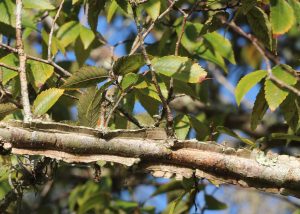Winged Elm, Ulmus alata

Photo by Scott Zona

Photo by Scott Zona

Photo by Mary Keim
Height: 40-70 feet
Spread: 30-40 feet
LANDSCAPE USE
A neat, clean, erect tree useful along streets and roadsides, or for shade in yards, parking lots, and along sidewalks.
FORM
A tough, drought-resistant, medium-sized tree with a rounded crown and spreading branches typically lined with corky wings.
NATIVE RANGE
Moist to wet hammocks, rich woods, and bluffs. Virginia southward to Central Florida, and west to Texas. Suitable for inland use, not coastal.
CHARACTERISTICS
Flowers: Tiny, inconspicuous, reddish. Early spring.
Leaves: Alternate, lance shaped, small, 1-2 1/2 inches long, doubly toothed along the margins, typically asymmetrical near the base.
Fruit: Rounded, winged, hairy, flat and waferlike.
Bark: Grayish, shallowly furrowed, very attractive.
CULTURE
Soil: Prefers moist, fertile soils with pH 5.0-7.0, but adapts to or tolerates many soil conditions.
Exposure: Full sun to part shade.
Water: Thrives best and grows larger in moist situations, but very adaptable to drier situations including poor, sandy sites.
Hardiness Zones: 6 to 9.
Life Span: Relatively fast growing but short-lived. Less than 100 years.
BEST FEATURES including WILDLIFE SUPPORT
Fast growth rate. Clean appearance. Leaves sometimes tum a beautiful, soft yellow in fall. Tolerant of a variety of conditions. Excellent yard tree. Relatively free of pests and insects. Winged Elm is a larval host for the Question Mark butterfly. Birds love to forage for the larvae and the branching habit of this tree makes it a great bird nesting area.
COMPANION PLANTS
Basswood (Tilia americana), upland oaks (Quercus spp.), Pignut Hickory (Carya glabra), American Holly (Ilex opaca), Witch Hazel (Hamamelis virginiana), Needle Palm (Rhapidophyllum hystrix), Blue-stem Palmetto (Sabal minor), Coral Honeysuckle (Lonicera sempervirens), Sweetgum (Liquidambar styraciflua), Magnolia and Sweetbay (Magnolia grandiflora and M. virginiana), Red Maple (Acer rubrum), Eastern Gamagrass (Tripsacum dactyloides), Climbing Aster (Symphyotrichum carolinianum).
DISADVANTAGES
Shallow root system may prevent understory plantings.
ALLERGENIC AND TOXIC PROPERTIES
Oils in plants of this genus may rarely cause dermatitis, including rash and blisters. The pollen is allergenic and causes hay fever in some people.
SIMILAR AND RELATED SPECIES
Several members of the Elm family occur in Florida, many of which are used in landscaping. Most closely related are the American Elm (U. americana), preferably Florida population, and Cedar Elm (U. crassifolia).
However, the family previously also included the closely related Sugarberries and Hackberries (Celtis Iaevigata, C. iguanaea, C. pallida, and C. tenuifolia), the Planertree (Planera aquatica), and the Tremas or Nettletrees (Trema lamarkianum, T. micranthum).